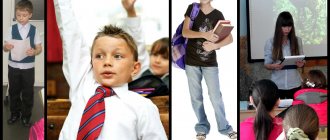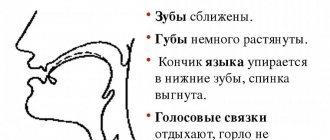Our speech is a stream of sounds that are formed with the participation of the organs of the speech apparatus and breathing. With proper speech breathing, we get correct sound production, correct volume, expressiveness and fluency of speech. Accordingly, harmonious speech is closely related to the development of speech breathing: how we breathe while speaking, with what force we inhale and exhale air, how we distribute exhalation and maintain pauses in conversation. All these skills in children can and should be improved. What games for developing speech breathing can be used for this? When to start?
What is the difference between speech breathing and physiological breathing?
Physiological breathing is involuntary; it serves us to ensure proper gas exchange in the body. Short and uniform inhalations and exhalations are performed through the nose: inhale-exhale-pause.
The main feature of the development of speech breathing in children is the emphasis on exhalation (it should be much longer than inhalation). First, take a short breath, followed by a short pause, then a long exhale, filled with sounds or words.
A person cannot speak while inhaling. That is why the main role in correct speech production is played by the training of speech exhalation. Here it is important to be able not to draw in as much air as possible, but to train the skill of using it rationally for a long, smooth exhalation. Relaxation of the muscles involved in such breathing occurs voluntarily, depending on our desire.
Imperfections in children's speech breathing can manifest themselves in different ways.
- For example, a child suddenly becomes silent while speaking, pauses and inhales to finish a phrase that he may forget while inhaling. To avoid this, the child is forced to finish the phrase, lowering the tone, sometimes switching to a whisper. This indicates that the baby does not know how to take in enough air during inspiration.
- Another example. The baby speaks very quietly, without finishing the thought. His speech is unclear and fast, which interferes with correct intonation and pauses. Here the child's respiratory apparatus is poorly developed. This is often due to the presence of chronic diseases of the ENT organs or a sedentary lifestyle when lung capacity suffers.
Freaks in a glass
You will need:
- disposable cup;
- a plastic glove (or rubber, but it’s harder to inflate);
- markers;
- cocktail tube.
Who will jump out of the cup is entirely decided by the author of the work. Maybe a kind monster with five eyes, or five monsters at once, or the baby’s favorite characters. Or maybe there will be pieces of paper attached to the glove with a message. Have time to read it while your child has enough breath to show it to you.
Organizing correct exhalation
In order for speech breathing to be correct, it is important to demonstrate to the baby the technique of performing it:
- the inhalation is short but strong, you need to inhale through your nose, and the expansion of the diaphragm will be noticeable;
- exhalation should be smooth, without sudden shocks (lips drawn out into a tube);
- exhalation is carried out through the mouth, otherwise speaking will not be possible;
- you need to exhale “all the way”, after which you take a short pause (about 2 - 3 seconds).
Most kids don't get it right the first time. To help them master breathing while speaking, special training will be needed. But don’t be afraid of this phrase: training consists of playing a variety of fun games with your child, which will bring him a lot of positive emotions, while simultaneously developing the power of exhalation.
To maintain interest in such activities, it is important to organize speech breathing exercises for children correctly:
- They are allotted from 3 minutes at an early age to 6 minutes at an older preschool age.
- Such games are played in a well-ventilated room: there should be enough fresh air during the lesson.
- You need to play with your breathing before eating.
- By the time the exercises begin, the child should be healthy and in a good mood.
- Parents always accompany the games with emotional comments.
Machine with inflatable motor
You will need:
- cardboard from any box;
- cocktail sticks;
- wooden skewers;
- scotch;
- plastic covers;
- inflatable ball.
In order for the car to move, you will have to inflate the balloon each time, at the same time training your breathing for speech.
In this article you will find 14 ideas for winter and New Year crafts for the diligent and always busy.
- share with your friends!
Playing with breath
You can start training in speech breathing by the end of the baby’s first year of life. Surely mommy will want to teach him how to blow out the candle on his first anniversary cake.
Place the candle at a short distance from the baby so that the force of his exhalation is enough to extinguish it. Otherwise, he will quickly lose interest in an exercise that does not work out. Be prepared for the fact that your child may not succeed either the first or even the fifth time. Show him an example, you can encourage him with phrases like: “Oh, what a stubborn little candle we have, she won’t give up! But Katyusha is stronger than her, right? Let's try to defeat her one more time!"
To make it more interesting for the baby, you can present this game as a birthday party for some toy (dolls, bears, bunnies): put out a small cake with a candle, “invite” other toys.
This will be the beginning of breathing exercises. You can add another fun activity to blowing out a candle: blowing soap scum off your hands while your baby is taking a bath. After a year, the baby can already try blowing dandelions while walking, blowing a child’s pipe, and showing how a samovar puffs.
For the most part, games for the development of speech breathing are intended for children, starting from early preschool age (3 - 4 years). By the way, many of them are held in kindergartens.
Bubble Blower
You will need:
- cocktail straws;
- glue gun (and adult help);
- ruler;
- felt-tip pen;
- scissors;
- soap bubble solution.
Even speech therapists recommend blowing soap bubbles to work on speech breathing. This lesson teaches you how to control the force of the blown stream: blow too hard and the bubbles will burst; blow too little and they won’t inflate and fly away. Well, since all this is incredibly fun, the children are ready to train again and again.
Breathing games
To carry out these games you will need simple equipment: paper devices, whistle toys, balloons.
- Flying butterflies.
It is necessary to cut out several paper butterflies and tie them by a thread to a strong rope at a short distance from each other. Butterflies should be positioned at the level of the child's face. An adult shows him how to blow on butterflies so that they begin to “flutter”, and then asks him to repeat. It is important that the baby stands straight, does not raise his shoulders as he exhales, does not puff out his cheeks, does not suck in air, and pulls his lips forward a little.
- Rainbow bubbles.
The mother shows the child how to blow soap bubbles using a straw, a cocktail tube or a special frame that comes with the bubbles. Then the baby tries to repeat. He may have difficulties, so the task of adults is to support the baby and motivate him.
- Whistles.
You will need wooden, clay or plastic whistle toys. The child is asked to whistle to hear his bird or animal sing. This is a very exciting game for preschool children; they will “whistle” with pleasure.
- Magic breeze.
You need to prepare “trees” - panicles made of colored paper cut into strips and attached to a stick (you can use Christmas tree “rain” instead of paper). An adult shows the child a magic tree and offers to blow on it to hear a light magical breeze.
- Flying ball.
To play, you need an inflated balloon, which is hung at the level of the baby's face. The parent shows the child how to blow on the balloon to make it fly up. The little player must repeat the exercise. A more difficult option is that the ball is not tied, and the child’s task is to lift it up and hold it there, using only the force of exhalation.
Dog tease
You will need:
- double-sided colored paper: brown, red and beige;
- some white and black paper, single-sided;
- Double-sided tape;
- cocktail straw;
- scissors;
- glue.
Using this technology, you can create not only a dog, but also anything you want. Give your child a couple of ideas and see how his imagination will no longer be stopped. By the way, if you are planning a children's party, it would be great to make such a craft for each guest - it will definitely be fun.
We play with what's at hand
To play, developing the power of exhalation, it is not necessary to use any equipment. There are games that are played “without anything”, or with objects that are always at hand.
- Let's sing!
During this game, the songs are a smooth stretching of different vowel sounds. First, the mother shows the child how to sing the sound A, then O, U, Y, I, E, etc. When the baby begins to produce rather long “songs,” you can invite him to combine them: a song can consist of a sequence of vowels: A-O-I, A-U-E, etc.
- The snowball has started!
To play, you will need small pieces of ordinary cotton wool, which is found in every home. They are laid out on the table, and the adult invites the child to imagine that winter has come and it is snowing. To do this, you need to blow on the “snowflakes” so that they fly off the table. In the group version of the game, children can compete, for example, whose snowflakes will fly off first, or whose snowflakes will fly farthest.
- Living pencils.
Colored pencils are laid out on the table (round ones are more convenient to start with, later you can use ribbed ones). The child’s task is to roll each pencil with the force of exhalation to the other end of the table. In a group version, children sit opposite and roll pencils to each other from one end to the other.
Exercises for young children
You can do breathing exercises with children starting from 1-2 years old. Exercises are best done together with movements - this way you will also develop the motor sphere.
- Invite your child to pretend to be a pump and pump up a deflated tire. Clench your hands in front of your chest into fists as if you were holding a pump. Lean forward and lower your arms, while voicing your actions with the sound “S-S-S”.
- Say the sound first loudly and then quietly.
- Draw a lumberjack with your child. Place your hands together as if holding an axe. Sharply lower your arms in a tilted position and exhale, saying “Uh.”
- Invite your child to imagine that he is a wizard. Swing your arms and hold them at the top. Smoothly lower them, pronouncing the syllables “Mmmaaaa, mmmmooooo, mmmmuuu.”
Also, breathing exercises can be combined with articulatory gymnastics when practicing lip movements: “Ring”, “Tube”, “Wide Open Mouth”, “Smile”. You can accompany these exercises with the following instructions: inhale through your nose and pronounce a vowel sound as you exhale.
Exercises for children 3-4 years old
You can use all the exercises listed above. But during this period, parents most often turn to a speech therapist for help to correct speech deficiencies. And to produce certain sounds, special exercises are needed that form not only a strong exhalation, but also the desired position of the articulation organs.
- For whistling: an adult asks the child to put his tongue on his lower lip, and, saying “F,” blow off a piece of cotton wool or other light object.
- To produce hissing sounds, the tongue must be in the upper position. A small piece of cotton wool is placed on the tip of the nose. The child cups his tongue and blows on it, trying to blow away the cotton wool.
For a change, you can invite your child to draw using paints. To do this, place a few drops of paint on a piece of paper and suggest blowing on them through a straw to make beautiful patterns. A good exercise for developing a smooth, long exhalation is various chants that are used in music classes. Also, singing contributes to the formation of diaphragmatic breathing skills, which underlies speech breathing.









